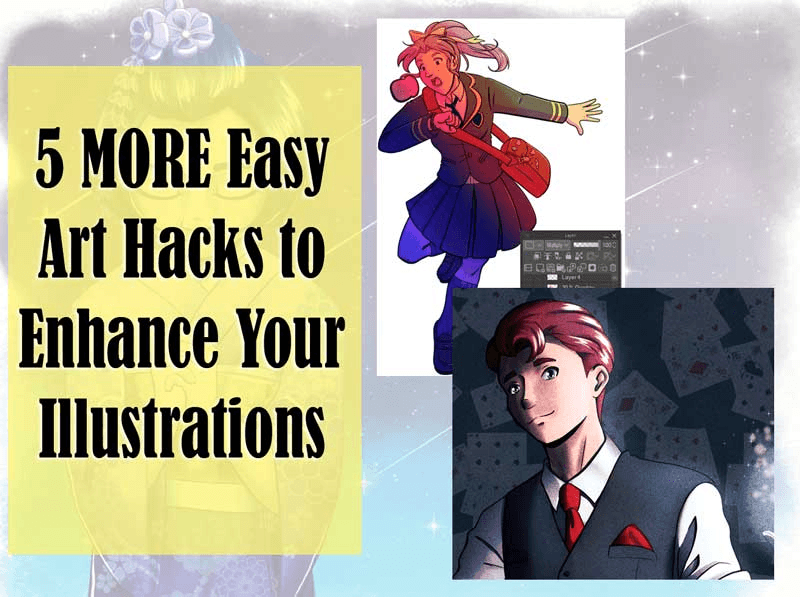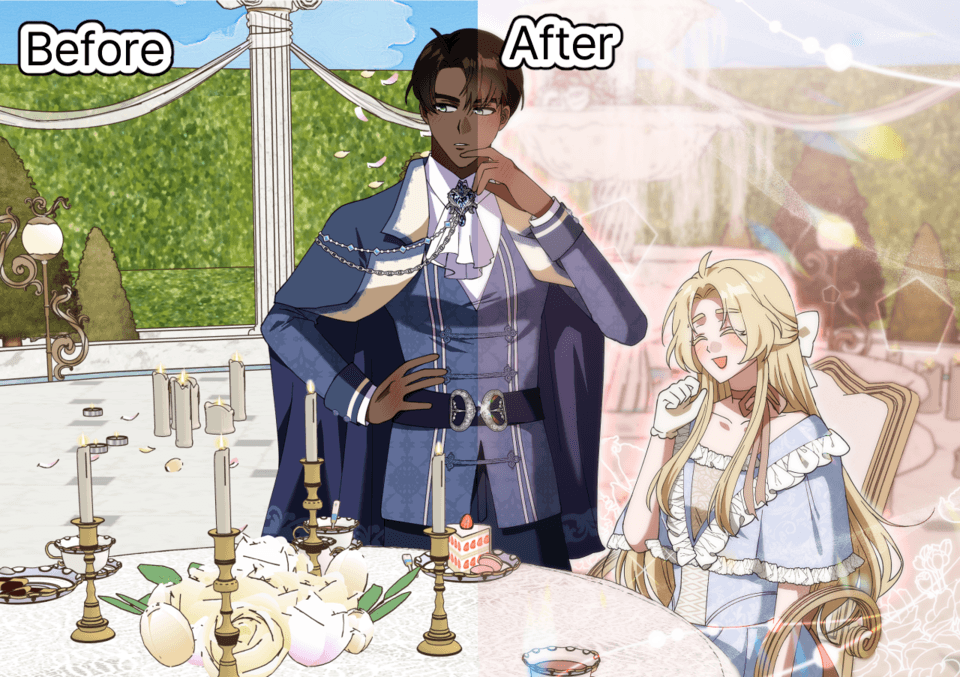Let's Draw Hands! A Simple Guide for Creating Human Hands
This tutorial is a breakdown of how I learned to draw hands and my process of creating them. It’s a simple and practical guide that can be used by artists at any skill level. From sketch to final render, my guide can help you master hands in no time!
INTRODUCTION
Hello there! My name is INKY. I’m a digital illustrator and designer and have been using Clip Studio Paint to create for years.
Hands are one of the most challenging things to draw, they seem simple, but actually have a complex range of muscles, shapes and folds. Understanding how to draw hands correctly can add a lot of value and dynamic realism to your illustration.
So, how exactly does one master drawing hands?
UNDERSTANDING HAND ANATOMY
Before you start to draw hands, it’s important to have an understanding of hand anatomy. This can help you understand what creates the form of a hand (muscles, tendons, joints and bones) and how it bends and moves in real life.
You don’t need to know the technical terms, but grasping a generalized idea of where the joints and major muscles are will help you in the long run.
How to Learn
Online
Proko and Marc Brunet offer fantastic anatomy resources to learn from and I recommend checking them out if you want to master drawing hands.
Books
Personally, I love the Morpho series by Michel Lauricella. This series has a great selection of different anatomy books (there’s even one just for hands and feet) and breaks down complex structures into simple forms you can reference quickly. These books are inexpensive and are small enough to bring with you wherever you go.
For more detailed instruction on the hand, the book Anatomy: A Complete Guide for Artists by Joseph Sheppard is my go to. This book breaks down the hand in technical and simplified forms. Additionally, it also provides drawings of the hand at different angles and viewpoints.
GATHERING REFERENCE MATERIALS
For the love of everything that is art, please do not draw from your imagination! If you want to master drawing something like a hand, you need to use reference materials that are found either in real life or digitally through 3D models and images.
Using references to create your piece isn’t cheating either! I’m not sure where this belief came from, but by using reference materials to draw from, you’re leveling up your drawing skills, especially when it comes to drawing the hand.
Reference Materials to Use
3D Models
3D models can be great to render a quick character pose, and luckily Clip Studio Paint has a lot of options already in the software. Simply go to Window>Material>Material:Pose to open up the various hand and body poses in the software. Click what you like and drag it into your canvas for reference.
You can also use the 3D tools (up top and below) to move the model around, create a new pose or save it as a new material.
Additionally, you can quickly turn poses from images into a 3D model by going to File>Import>Pose Scanner and then selecting the image you want to use.
Clip Studio Paint will turn it into a custom 3D model for you!
The Clip Studio Assets page also has a plethora of hand models to choose from, some require Gold or Clippy Points, while others are free to use.
Here are some of my favorites:
Online Images
You can quickly search on Google for what you are looking for (hands folded, hands making a peace sign, hands holding something, etc.) and you’ll find a variety of references to use in your next project.
Taking a Selfie
You can also take an photo (or have someone help you) of yourself making the pose that you want with your hands.
This is often my go to method as I can’t always find what I want online. I use a tripod and my phone’s camera timer to take the picture. It saves me a lot of time instead of having to search for what I want.
Breaking Down Reference Materials
Create Simple & Large Shapes
Breaking down reference materials will help you see the form of the hand more clearly and understand what to put on your canvas. To breakdown parts of an image, simply draw over it with different brushes and colors.
I highlight the joints of the fingers and bends with circles, link them with lines, and then block out the rest of the shapes. Typically, I focus on the muscles of the palm and thumb as they’re the biggest structures and difficult to draw.
For something where the hands are looking at you or towards the viewer, it’s best to emphasize foreshortening as in the image above.
HOW TO DRAW HUMAN HANDS
Now that you have a bit of an understanding of how the human hand is structured and have gathered some references, let’s move on to actually drawing and rendering the hand.
Focus on Form
When drawing hands, do not worry about the full character or body of what you’re drawing. Focus on the placement and size of fingers, nails, palm, hand and wrist.
Do not worry about jewelry, values/shading or the texture of the hand, focus on the overall shape and structure. You can worry about details after the fact.
It’s best to have the form and structure of the hand down first before you move onto coloring, lighting and other elements.
Keep it Simple
Additionally, it’s also best to start with simple poses or studies at first. Trying to draw the hand foreshortened (where it looks at the viewer) can be overwhelming and become frustrating.
I would suggest drawing the hand as it is (flat without a dynamic pose) and then, when you’re more comfortable, slowly move on to drawing it bending, holding objects, etc.
Breakdown of My Process

Rough Sketches
When drawing hands, I always start with super rough sketches and add layers on top as I go.
I do this to understand the structure of the hand, but also to make sure the composition flows and makes sense. I block out the larger shapes and then go in with smaller brushes to refine the hand.
During this stage, I am constantly looking back and forth at my drawing and my reference material to check for accuracy.
Line Art
Once I am satisfied with my sketches, I move on to the line art stage to give a stronger emphasis on the form and to make the coloring process easier.
For the nails and folds on the knuckles, I make my line art thinner and lighter, while bigger muscles around the thumb and palm have a varied line weight.
I also always draw my line art with the vector layer option to make it easier to resize my lines if needed after the first pass.
Base Colors/ Flats
In this stage, I lay down the overall colors of the illustration. You can either use the magic wand tool or paint bucket tool to fill your colors in.
When drawing hands, I recommend this color set from the Clip Studio Paint Assets page for coloring flesh tones:
Creating Values
The next stage is focused on lighting, shading and values. I create a grayscale coloring using the lasso fill tool, and then create a wider range of values by blending with various brush tools.
Below is the color set that I use and created for such colorings:
Final Rendering
In the final stage, I color over my grayscale values, and then overlay that on top of my base colors.
I’ll also add touches like shine, texture or airbrush effects as needed.
FINAL THOUGHTS
Feeling Stuck & Intimidated About Drawing Hands?
Remember Practice & Patience!
Like anything, learning a skill like drawing hands takes time and you need to continually practice to get better. You probably will be frustrated and your illustration might not look how you want it to at first, but that’s okay. You just need to get the basic structure and form down, as hands don’t require a ton of detail.
In order to make good art, you have to make bad art too. Keep going and don’t give up, reflect on what you’ve accomplished because drawing hands can be challenging and some of the most experienced artists struggle to draw them correctly. I know I still do, but just keep practicing and creating!
When I first started my art journey, my hand drawings weren’t the best, but when I compare them to where I am now, I have to say I’ve improved greatly and can confidently share my knowledge with you.
Happy creating everyone! I hope you found my tutorial valuable. I’d love to see your hand drawings, so feel free to tag me on social media and if you found this guide helpful, don’t forget to like and share!


















Comment